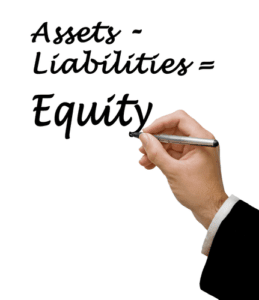
Venture capitalists look to hit big early on and exit investments within five to seven years. An LBO is one of the most common types of private equity financing and might occur as a company matures. At some point, the amount of accumulated retained earnings can exceed the amount of equity capital contributed by stockholders. Retained earnings are usually the largest component of stockholders’ equity for companies operating for many years. Market analysts and investors prefer a balance between the amount of retained earnings that a company pays out to investors in the form of dividends and the amount retained to reinvest into the company. All the information needed to compute a company’s shareholder equity is available on its balance sheet.
Where to Find Data for Company Equity

Zacks Rank stock-rating system returns are computed monthly based on the beginning of the month and end of the month Zacks Rank stock prices plus any dividends received during that particular month. A simple, equally-weighted average return of all Zacks Rank stocks is calculated to determine the monthly return. Only Zacks Rank stocks included in Zacks hypothetical portfolios at the beginning of each month are included in the return calculations. Certain Zacks Rank stocks for which no month-end price was available, pricing information was not collected, or for certain other reasons have been excluded from these return calculations.
- We Fools may not all hold the same opinions, but we all believe that considering a diverse range of insights makes us better investors.
- Some companies will still issue paper certificates if you ask them for one, but most stock today is handled digitally.
- For example, if a company reports a return on equity of 12% for several years, it is a good indication that it can continue to reinvest and grow 12% into the future.
- She’s entitled to $5,000 of the dividend, leaving Anne and Alex to split the rest.
- At some point, accumulated retained earnings may exceed the amount of contributed equity capital and can eventually grow to be the main source of stockholders’ equity.
- Owners of a company (whether public or private) have shares that legally represent their ownership in the company.
Real-World Examples

Zacks may license the Zacks Mutual Fund rating provided herein to third parties, including but not limited to the issuer. Shareholders’ equity is the total value of the company expressed in dollars. Put another way, it is the amount that would remain if the company liquidated all of its assets and paid off all of its debts.

Equity Meaning: How It Works and How to Calculate It
On the balance sheet, asset accounts are listed in order of their liquidity — how easily they can be converted into cash. They are also divided into current assets and non-current or long-term assets. Current assets can be converted to cash within one year or the company’s operating cycle. Meanwhile, non-current assets include long-term investments, fixed assets, and intangible assets. In the case of acquisition, it is the value of company sales minus any liabilities owed by the company not transferred with the sale. A Total Equity Calculator is a financial tool used to determine the total equity of a company or individual.
How to Calculate Total Assets, Liabilities, and Stockholders’ Equity
- Stockholders’ equity is also referred to as shareholders’ or owners’ equity.
- This is the percentage of net earnings that is not paid to shareholders as dividends.
- Return on equity is a measure that analysts use to determine how effectively a company uses equity to generate a profit.
- Shareholder equity represents the total amount of capital in a company that is directly linked to its owners.
It is obtained by taking the net income of the business divided by the shareholders’ equity. Net income is the total revenue minus expenses and taxes that a company generates during a specific period. Similarly to assets, liabilities are divided into current liabilities, which include things like rent, tax, utilities, debts that are payable within a year, and dividends payable. «Long-term liabilities» generally refers to long-term debt the company has issued (bonds), but can include other non-immediate expenses such as pension obligations. To calculate total equity, subtract the total liabilities from the total assets.
Understanding Shareholder Equity (SE)
When it is used with other tools, an investor can accurately analyze the health of an organization. Shareholder equity is the difference between a firm’s total assets and total liabilities. This equation is known as a balance sheet equation because all of the relevant information can be gleaned from the balance sheet. By subtracting the total liabilities from total equity formula the total assets, you arrive at the total equity, which represents the residual value after deducting debts from assets. Since equity accounts for total assets and total liabilities, cash and cash equivalents would only represent a small piece of a company’s financial picture. Stockholders’ equity is the amount of the company that is «owned» by investors.
She’s entitled to $5,000 of the dividend, leaving Anne and Alex to split the rest. Notice how Anne & Company sold Anne’s mom a special kind of stock called preferred stock. Let’s say your friend owns a successful robot lawn mowing business (“think of it as a Roomba for grass,” he tells you) that you want in on. You were broke when the company first incorporated last year, but you have some extra cash now that you’d love to invest in the company. In addition to choosing a name, appointing directors, and filing certain documents, incorporation also involves issuing shares. Here, we’ll assume $25,000 in new equity was raised from issuing 1,000 shares at $25.00 per share, but at a par value of $1.00.
- These equity ownership benefits promote shareholders’ ongoing interest in the company.
- Investors usually seek out equity investments as it provides a greater opportunity to share in the profits and growth of a firm.
- Think of retained earnings as savings, since it represents the total profits that have been saved and put aside (or “retained”) for future use.
- Long-term assets are possessions that cannot reliably be converted to cash or consumed within a year.
- You can find that information by typing your home address into the search box on Redfin.com, and then viewing the page with all the details on your home.
- Retained earnings are usually the largest component of stockholders’ equity for companies operating for many years.
